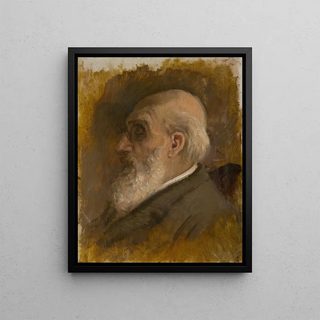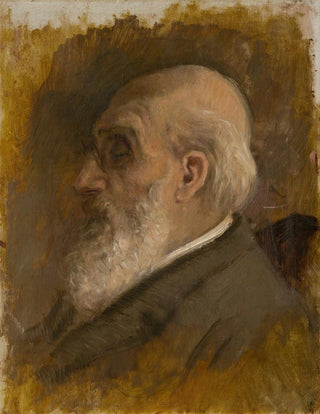Art print | Portrait of the painter's father with pince-nez - Ladislav Mednyánszky


View from behind

Frame (optional)
The art print "Profile of the painter's father with pince-nez" by Ladislav Mednyánszky is a piece that invites contemplation and reflection. In this intimate portrait, the artist captures not only the physical features of his father but also an essence, an atmosphere that evokes the complexity of family relationships. The pince-nez, a subtle yet significant detail, adds a touch of sophistication and erudition to the paternal figure, while revealing an era when this type of accessory was synonymous with culture and refinement. The scene, bathed in soft and warm tones, immerses us in a universe where each brushstroke seems charged with meaning and emotion.
Style and uniqueness of the work
Mednyánszky's style stands out for its ability to combine realism and impressionism, creating an atmosphere that is both intimate and universal. In this work, the texture of the clothing and the expression on the face are treated with remarkable meticulousness. The artist uses shades of color that play with light, giving his father an almost lifelike presence. The blurred background, which contrasts with the sharpness of the portrait, emphasizes the importance of the central figure while suggesting an external world from which the painter chooses to distance himself. This stylistic choice allows the viewer to focus on the emotion conveyed by the father's gaze, a gaze that seems both wise and melancholic, reflecting a past filled with stories.
The artist and his influence
Ladislav Mednyánszky, born in 1852 in Hungary, is an artist whose journey is marked by a profound search for identity and a quest for beauty. Influenced by the artistic currents of his time, he manages to develop a style that is uniquely his own, blending elements of academic tradition with impressionism. Mednyánszky is also a keen observer of his environment, which is reflected in works that capture daily life, landscapes, and portraits. His introspective approach and commitment to representing human life make him an essential painter of his era. Through his works, he has been able to convey

Matte finish

View from behind

Frame (optional)
The art print "Profile of the painter's father with pince-nez" by Ladislav Mednyánszky is a piece that invites contemplation and reflection. In this intimate portrait, the artist captures not only the physical features of his father but also an essence, an atmosphere that evokes the complexity of family relationships. The pince-nez, a subtle yet significant detail, adds a touch of sophistication and erudition to the paternal figure, while revealing an era when this type of accessory was synonymous with culture and refinement. The scene, bathed in soft and warm tones, immerses us in a universe where each brushstroke seems charged with meaning and emotion.
Style and uniqueness of the work
Mednyánszky's style stands out for its ability to combine realism and impressionism, creating an atmosphere that is both intimate and universal. In this work, the texture of the clothing and the expression on the face are treated with remarkable meticulousness. The artist uses shades of color that play with light, giving his father an almost lifelike presence. The blurred background, which contrasts with the sharpness of the portrait, emphasizes the importance of the central figure while suggesting an external world from which the painter chooses to distance himself. This stylistic choice allows the viewer to focus on the emotion conveyed by the father's gaze, a gaze that seems both wise and melancholic, reflecting a past filled with stories.
The artist and his influence
Ladislav Mednyánszky, born in 1852 in Hungary, is an artist whose journey is marked by a profound search for identity and a quest for beauty. Influenced by the artistic currents of his time, he manages to develop a style that is uniquely his own, blending elements of academic tradition with impressionism. Mednyánszky is also a keen observer of his environment, which is reflected in works that capture daily life, landscapes, and portraits. His introspective approach and commitment to representing human life make him an essential painter of his era. Through his works, he has been able to convey






